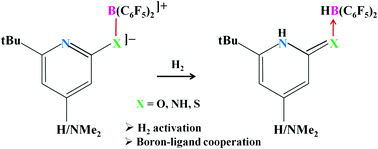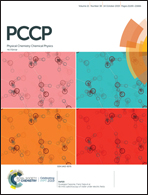A theoretical investigation on boron–ligand cooperation to activate molecular hydrogen by a frustrated Lewis pair and subsequent reduction of carbon dioxide†
Abstract
The role of boron–ligand cooperation in activating molecular hydrogen by a set of six frustrated Lewis pair (FLP) systems is explored using density functional theory. The results obtained from thermochemical calculations show that all the studied FLP systems are capable of activating molecular hydrogen as the activation free energies are not too high (17.6–25.6 kcal mol−1). Sulphur based FLP 6 is the most promising one as it results in the smallest activation barrier among the studied sets. For a given FLP, the introduction of an electron donating –NMe2 group at the para position of the pyridine ring somewhat lowers the barrier and enhances the B–X (X = O, N, S) interaction. The B–X bond present within the FLPs plays a crucial role in facilitating the H2 activation process where it gets changed from the B+–X− type of interaction in the FLP to the B ← X dative bond upon H2 activation as understood from the energy decomposition analysis in combination with the natural orbital for chemical valence theory (EDA-NOCV). This mode of operation is termed as boron–ligand cooperation in analogy with the metal–ligand cooperation in transition metal complexes. The EDA-NOCV results obtained at the TS also support an electron transfer model where simultaneous electron transfer takes place from the Lewis basic center (N) of the FLP to σ*(H2) and from σ(H2) to the Lewis acidic center (B) of the FLP, resulting in a weakened H–H bond. The change in the aromaticity of the pyridine rings during the course of H2 activation is also monitored by nucleus independent chemical shift calculations. Finally, the ability of the studied FLP systems to act as hydrogenation catalysts is elucidated by studying the hydrogenation of CO2 to yield formic acid.

- This article is part of the themed collection: 2019 PCCP HOT Articles


 Please wait while we load your content...
Please wait while we load your content...